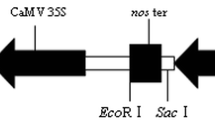Abstract
Modern sugarcane cultivars have complex genetic characteristics and low fertility that render their genetic improvement through traditional breeding difficult. Genetic engineering methodology to introduce foreign genes provides new opportunities for the genetic improvement of sugarcane cultivars. One of prerequisites for successful insertion of a gene cassette into the plant genome is the availability of an efficient transformation protocol. An improved protocol for Agrobacterium-mediated transformation of sugarcane is described. Between 85 and 100% of calli transformed using this procedure produced new calli, and 100% of them were positive for the inserted gene. The whole procedure permitted the production of transgenic calli in a short time (1.5 mo). The transformed calli can be cultured further for the production of the inserted geneencoded enzyme by using cell culture, or they can be regenerated into transgenic plants. This protocol may be implemented also for the generation of transgenic plants from other species.
Similar content being viewed by others
References
Cane taking larger share of world sugar output: sugarcane expected to be main supply of world sugar production in 1994/5. (1995) Agra-Europe. January 20, M7.
Ingelbrecht, I. L., Irvine, J. E., and Mirkov, T. E. (1999) Posttranscriptional gene silencing in transgenic sugarcane: dissection of homology-dependent virus resistance in a monocot that has a complex polyploid genome. Plant Physiol. 119, 1187–1197.
Arencibia, A., Molina, P., De la Riva, G., and Selman-Housein, G. (1995) Productions of transgenic sugarcane (Saccharum officinarum L.) plants by intact cell electroporation. Biotechnol. Appl. 9, 156–165.
Enriquez-Obregón, G. A., Vázquez-Padrón, R. I., Prieto-Samsonov, D. L., De la Riva, G. A., and Selman-Housein, G. (1998) Herbicide resistance sugarcane (Saccharum officinarum L.) plants by Agrobacterium-mediated transformation. Planta 206, 20–27.
Falco, M. C., Neto, A. T., and Ulian, E. C. (2000) Transformation and expression of a gene for herbicide resistance in a Brazilian sugarcane. Plant Cell Rep. 19, 1188–1194.
Belarmino, M. M. and Mii, M. (2000) Agrobacterium-mediated genetic transformation of a phalaenopsis orchid. Plant Cell Rep. 19, 435–442.
De Clercq, J., Zambre, M., Van Montagu, M., Dillen, W., and Angenon, G. (2002) An optimized Agrobacterium-mediated transformation procedure for Phaseolus acutifolius A. Gray. Plant Cell Rep. 21, 333–340.
Li, D. D., Shi, W., and Deng, X. X. (2002) Agrobacterium-mediated transformation of embryogenic calluses of Ponkan mandarin and the regeneration of plants containing the chimeric ribonuclease gene. Plant Cell Rep. 21, 153–156.
Hu, Z., Yang, J., Guo, G. Q., and Zheng, G. C. (2002) High-efficiency transformation of Lycium barbarum mediated by Agrobacterium tumefaciens and transgenic plant regeneration via somatic embryogenesis. Plant Cell Rep. 21, 233–237.
Bhatnagar, S. and Khurana, P. (2003) Agrobacterium tumefaciens-mediated transformation of Indian mulberry, Morus indica cv. K2: a time-phased screening strategy. Plant Cell Rep. 21, 669–675.
Montoro, P., Rattana, W., Pujade-Renaud, V., et al. (2003) Production of Hevea brasiliensis transgenic embryogenic callus lines by Agrobacterium tumefaciens: roles of calcium. Plant Cell Rep 21, 1095–1102.
Enriquez-Obregón, G. A., Vázquez-Padrón, R. I., Prieto-Samsonov, D. L., Pérez M., and Selman-Housein, G. (1997) Genetic transformation of sugarcane by Agrobacterium tumefaciens using antioxidants compounds. Biotechnol. Appl. 14, 169–174.
Frisch, D. A., Harris-Haller, L. W., Yokubaitis, N. T., Thomas, T. L., Hardin, S. H., and Hall, T. C. (1995) Complete sequence of the binary vector Bin 19. Plant Mol. Biol. 27, 405–409.
Greiner, R., Konietzny, U., and Jany K.-D. (1997) Cloning, characterization and overexpression of a phytase-encoding gene of Escherichia coli ATCC 33965. In Jahrestagung ’97, (Ureysa, G. and Wagemann, V., eds.), DECHEMA, Frankfurt, pp. 156–158.
McBride, K. E. and Summerfelt, K. R. (1990) Improved binary vectors for Agrobacterium-mediated plant transformation. Plant Mol. Biol. 14, 269–276.
Greiner, R., Konietzny, U., and Jany, K.-D. (1997) Is there any possibility of detecting the use of genetic engineering in processed foods? Z. Ernährungswiss 36, 155–160.
Greiner, R. and Jany, K.-D. (2002) Use of polymerase chain reaction (PCR) in food control: detection of genetically modified food and food-borne pathogens. Pol. J. Food Nutr. Sci. 11, 112–118.
Trick, H. N. and Finer, J. J. (1997) SAAT: Sonication assisted Agrobacterium-mediated transformation. Transgenic Res. 6, 329–336.
Trick, H. N. and Finer, J. J. (1998) Sonication-assisted Agrobacterium-mediated transformation of soybean (Glycine max [L.] Merrill) embryogenic suspension culture tissue. Plant Cell Rep. 17, 482–488.
Author information
Authors and Affiliations
Corresponding author
Rights and permissions
About this article
Cite this article
Santosa, D.A., Hendroko, R., Farouk, A. et al. A rapid and highly efficient method for transformation of sugarcane callus. Mol Biotechnol 28, 113–119 (2004). https://doi.org/10.1385/MB:28:2:113
Issue Date:
DOI: https://doi.org/10.1385/MB:28:2:113




